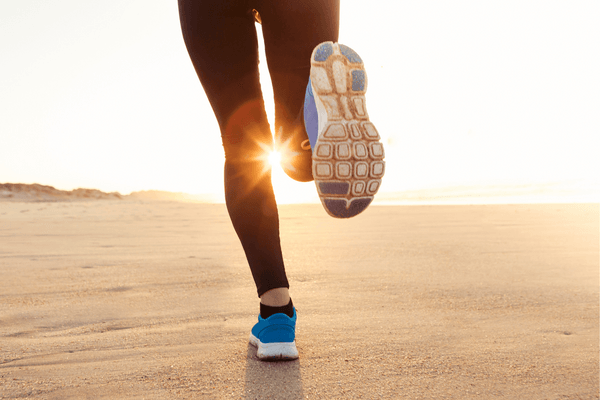Most of us have experienced the impact that sunshine can have on lifting our mood. But is running under the sun good? The answer is yes, with precautions!
Running outdoors offers multiple benefits. The scenery and terrain are stimulating, which fuels your stamina. And the weather and time of day also have a significant impact.
Personally, I like running at night in winter. The darkness offers anonymity, and the cool air stops me from overheating. Nevertheless, running in the sun can be a wonderful experience too. But is running under the sun good? The answer is yes and no. Running under the sun offers certain health benefits, but you must take precautions to protect yourself from damaging UV rays. In addition, you need to make sure you stay suitably hydrated.
If you are like me and favor winter running, there are other considerations to ensure you are protecting yourself. Check out our article on the best running gloves for extreme cold weather.
Contents
Is Running Under the Sun Good? Yes! Here are the Benefits.
If you love the outdoors and are a bit of a sun worshipper, you’re in luck. There are several reasons why running under the sun is good for you.
Vitamin D Production
Few foods contain a natural source of vitamin D unless manufacturers fortify them. For this reason, spending time in the sun is crucial, as your body can produce vitamin D when sunlight reaches your skin.
Experts recommend spending 10 – 30 minutes in the sun several times a week. So, you can quickly kill two birds with one stone by running for exercise while your body produces a natural source of vitamin D.
You might also be interested in our explainer on what are strides in running.
Potential To Run Faster

If you’re surprised that we are advocating running in the sun, note that we’re talking about sunlight here, not heat. So, if the temperature is comfortable and you’re running in the sun, there’s a possibility that you might run faster.
The reason for this is that sunlight activates nitric oxide in the body. Nitric oxide is responsible for increasing blood flow. And as so many runners can attest, increased blood flow correlates with more oxygen circulating around your body.
That being said, remember you are likely to get warmer when running in the sun, so ensure you stay hydrated. Have a look at our article on how to carry water when running.
Reduced Chance of SAD
Seasonal Affective Disorder (SAD) is a temporary form of depression from less sunlight exposure in the fall and winter. If you usually would turn to your treadmill for running during the coldest time of year, you could significantly improve your mood by going outside and running in the sun.
Studies have found that people living far from the equator have an increased risk of developing SAD. So, if you live in an area with a lot of clouds and feel it could be dampening your mood, you might want to talk with your doctor about supplementing your runs with light therapy.
Downsides To Running Under the Sun
Despite the benefits you gain from running under the sun, the reality is that doing so without preparation can lead to serious health consequences. Below are some of the most significant areas of concern for sunshine-loving runners.
Sunburn
Running or not, we all know that we should wear sunscreen before spending time in the sun. But unfortunately, common sense isn’t always common practice.
Sunburn causes redness, pain, and flakiness in the short term, which could temporarily hinder your running schedule. The long-term effects are far more troubling, though.
Melanoma, basal cell carcinoma, and squamous cell carcinoma are all types of skin cancer that can develop due to too much sun exposure without sunscreen. Regularly getting sunburned while running can also lead to accelerated skin aging.
Eye Damage

Running without sunglasses can take a terrible toll on your eyes over time. By doing so, you open the opportunity for several eye conditions, including:
- Cataracts
- Pterygium
- Keratitis
- Macular degeneration
You can also develop cancer on your eyelid, given that most people don’t cover it with sunscreen.
Luckily, protecting your eyes from the sun is easy: simply wear sunglasses with UVA and UVB labels. You can also reduce the amount of sunlight that reaches your eyes by wearing a hat when running.
Increased Risk of Immunity Issues
Here’s a sobering fact for marathon runners: Doing intense, long training sessions can temporarily weaken your immune system.
Scientists estimate that depending on the nature of your exercise, your immunity can decrease anywhere from 3 – 72 hours, giving viruses and bacteria a chance to take hold of your body.
You’ll likely have this immunity-reducing impact if you run ten miles or more at a time. So, if you’re running under the sun for a double-digit number of miles, you might increase your risk of developing the above conditions.
Tips for Protecting Yourself From the Sun While Running
The answer to “Is running under the sun good?” depends on how well you protect yourself from the sun’s damaging UV rays. Luckily, you have many options. They include:
- Applying sunscreen
- Wearing sunglasses
- Putting on a hat
- Wearing long-sleeved shirts and pants
- Staying hydrated
It’s easy to forget about your lips, so apply a lip balm with SPF protection.
When choosing running clothes, pick those that come with UPF protection. Polyester and nylon are both excellent materials for disrupting UV rays. You should also select clothing with tighter woven fabric, as it reduces how much UV transmission occurs.
Generally speaking, cotton, flax, and rayon fabrics are the worst materials for UV protection unless manufacturers treat them.



